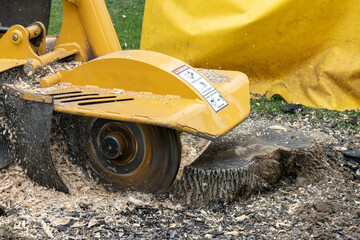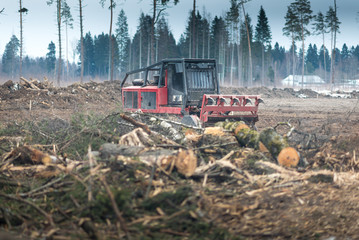Stumps left in the ground can rot and encourage weed growth and pest infestation. They can also be unsightly and dangerous.
There are several ways to remove a tree stump, from digging it out to burning it away. You can also use a stump grinder or chemical stump removal products. It is best to call Tino’s Tree Service if you don’t know how.

Manual Removal
If you don’t want to spend money on chemical removal, or you prefer a natural approach, you can remove a stump by hand. However, this method is more labor intensive and may take up to 12 hours to complete. It is important to use proper safety gear such as work gloves and steel-toe boots to minimize the risk of injury.
Before you start digging, it is important to determine the size of the stump and its root system. This will help you determine how much effort and equipment you’ll need. For example, a large stump can be more difficult to dig out than a small one. It’s also important to identify any underground utilities in the vicinity of the stump before beginning the process. If you are unsure about the location of these utilities, it is best to hire a professional.
Begin by digging around the stump, making sure to remove as many roots as possible. Then, use a stump grinder to grind down the remaining wood and roots. You’ll need to continue grinding until the stump is approximately 4 inches below the ground. Once the stump is removed, fill the hole with dirt and cover it with a layer of grass.
Alternatively, you can leave the stump in place and let it decompose naturally. This can be a good option for smaller stumps, but it will take several years before the stump is fully decomposed.
If you do decide to leave the stump in place, make sure to cover it with a thick layer of mulch. This will prevent unwanted vegetation from growing and protect the soil underneath.
Stumps are more difficult to remove when they’re young, as they tend to be firmer and have a higher rate of decomposition. Older stumps, on the other hand, are generally softer and easier to remove. Regardless of the age of the stump, it’s always important to evaluate its condition before using any removal methods. This will help you determine whether a certain technique is appropriate and safe for the situation. In addition, it’s essential to consult with a local tree service company before starting the process. They can provide specialized equipment and professional assistance to ensure the best results.
Chemical Removal
Stumps can be a nuisance and may pose safety hazards for people walking through the yard. They can also be difficult to remove physically. Stump removal chemicals can speed up the decomposition process and make it easier to dig or cut out the stump. However, it’s important to note that these products are not a quick fix and will take at least a few months to work.
Most commercial stump removal products contain potassium nitrate, which accelerates the decomposition of tree stumps. They can be purchased in liquid or granule form and should be applied according to the product’s instructions. They are usually poured into the holes in the top of the stump, but can also be used to treat a buried stump. The nitrates in the chemical penetrate the stump, thinning its cell walls and making it much easier to rot out the wood.
Before using a chemical stump killer, you should carefully examine the stump to ensure that it is dead. If there are any new sprouts, you should kill them with another method before applying the chemical. It is also a good idea to cover the stump with plastic sheeting to prevent rain from washing the chemicals away. It’s important to reapply the stump remover every one to two weeks for maximum effectiveness.
Another option for removing a stump is to burn it out. To do this, drill a series of holes into the stump and pour kerosene or fuel oil into them. Then, drop a match into each hole and wait for the stump to start smoldering. This method should be done with great care to avoid children or pets ingesting the toxic liquid.
Finally, you can use Epsom salt to kill a stump while improving the soil around it. Epsom salt draws the water out of the stump, causing it to die. It’s a natural alternative to rock salt or caustic lye, and it doesn’t add too much sodium to the soil. Moreover, it improves the soil’s magnesium and sulfur content, which plants require for chlorophyll production.
Stump Grinding
If you’ve recently had a tree cut down, the last thing you want is that unsightly stump left behind. Stumps are not only an eyesore, but they can also create safety hazards and be a magnet for pests and diseases. While some people choose to leave the stump in the ground to naturally decompose, this can take years and may be very costly for property owners.
Stump grinding uses a machine to grind the stump into mulch, effectively removing it from your landscape. The process is much quicker and less expensive than manual removal and is a good option for most homeowners. It can be even more cost-effective when you combine it with a root barrier installation, as the roots are prevented from growing back after grinding.
The main downside of this method is that it doesn’t remove the root system entirely, so some new sprouts are likely to grow around the stump. This can be avoided, however, by using a chemical treatment immediately after the stump is ground to prevent the roots from growing. The treatment has to be applied by a certified applicator and must be repeated after every stump grinding until the roots have been killed completely.
Stump grinding is also not the best option for people who are planning to replant in the same spot, as it disturbs the soil and can suffocate future plants. It’s a good choice for small backyard spaces, though, as it takes up very little space and can be used as a base for a bench or flower bed.
If you’re unsure whether stump grinding is right for you, reach out to your local tree service and discuss your options. They’ll help you determine which method is best for your specific needs and provide you with a quote. They’ll also be able to tell you about any potential risks or concerns that might arise with each option, such as the likelihood of new sprouts growing up around the stump and the type of root system that might be left behind after grinding.
Stump Burning
Burning a stump is one way to remove it without the use of expensive equipment. However, this method requires a lot of effort and is risky. You should make sure you have the proper safety gear and follow instructions on your equipment before you begin. It is also important to prepare the area around the stump before you start burning. Make sure to clear away all combustible materials and move structures and fences far enough from the stump. You should also check with your local fire department to ensure that they allow open burning in your area. If you live in a residential community, you may have to get permission from your neighbors before you burn a stump.
The first step in this process is to drill many holes into the top of the stump, leaving about an inch of space between each hole. Then, you should fill each hole with potassium nitrate or saltpeter. After the holes are filled, you should pour boiling water over them. This will help the potassium nitrate absorb into the entire stump and make it more flammable.
After the stump is saturated, you can pour kerosene over it to start the fire. It should take several hours for the stump to completely burn. However, you should not let the fire get out of control. You should monitor the fire closely and stoke it when necessary.
Once the stump is completely burned, you should break up the ashes and dispose of them properly. You can use a shovel to do this, but you should be careful to not touch the hot ashes. This could cause them to re-ignite and start the stump burning again.
Stump grinding is an alternative to burning, but it can be costly and require special equipment. It is also less effective and can damage the surrounding ground. Another option is to use a chemical solution to decompose the stump. Instructions for this method vary, but they usually involve drilling multiple holes into the stump and pouring a chemical into each hole. The chemical will eventually break down the cell walls of the stump, making it spongey and easier to remove.


